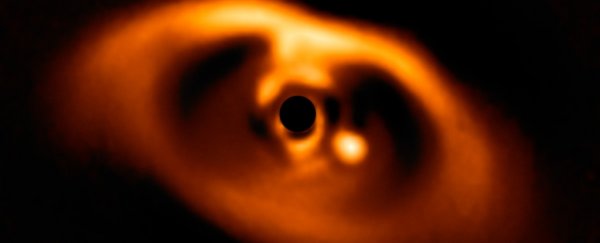For the very first time, astronomers have captured an image of a baby planet as it carves a path through the disc of dust that surrounds its star, an orange dwarf 113.4 parsecs (370 light-years) away from Earth.
The star is called PDS 70, and astronomers have long suspected the existence of the planet in orbit around it. They have named the newly discovered companion PDS 70b.
Although we have a pretty solid, plausible model of planetary formation, getting confirmation of it has proven a little more difficult.
We know that when stars are newly formed, they're orbited by a swirling disc of dust, rocks and gas around the equator. Planetary accretion is thought to occur when these particles collide with each other, gradually growing stronger gravitationally, collecting material from the orbital path and eventually forming a planet.
Astronomers have detected several protoplanetary discs, as these are known, with gaps consistent with this orbital clearing, and even obtained spectral data consistent with the presence of planets.
But actually photographing a planet being born is not so easy. This is because usually exoplanets are too far away, and therefore too faint to be picked up by our optical telescopes, especially when any light they may reflect is obscured by the brightness of its star - the same reason we can't see stars during daytime here on Earth.
A significant gap was discovered in PDS 70's protoplanetary disc in 2012, so this is where researchers from the Max Planck Institute for Astronomy and the European Southern Observatory decided to direct their search for a baby planet.
"These discs around young stars are the birthplaces of planets, but so far only a handful of observations have detected hints of baby planets in them," said astronomer Miriam Keppler of the MPIA.
"The problem is that until now, most of these planet candidates could just have been features in the disc."
PDS 70 has a few features that made it a good candidate for this sort of search. Its protoplanetary disc is large, spanning a radius of around 130 astronomical units (the distance between Earth and the Sun; the Kuiper belt only goes up to about 50 au).
As an orange dwarf, with a mass just under that of the Sun, it's also not tremendously bright, which means it's well suited for observation with a coronagraph. That's the black circle in the centre of the image, created by a disc used to occlude the bright light of the star so that other objects become visible.
Even so, special filters are required to block specific wavelengths of light to make other features visible.
This is where the specialised planet-hunting instrument SPHERE on the ESO's Very Large Telescope comes in. Using its coronagraph and polarisation filters, the team discovered a very large planet orbiting in the gap in PDS 70's protoplanetary disc - which means it's probably still in the process of accumulating material.

Further analysis of the planet, described in a second paper, was conducted based on its spectrum.
Its mass is several times that of Jupiter, and its orbit is around 22 au, just a little bit farther than Uranus's orbit around the Sun. It takes about 120 Earth years to complete one orbit around its star, and its surface temperature is around 1,200 Kelvin.
That's much hotter than any planet in our own Solar System - Venus is the hottest, and its average temperature is just 737 Kelvin.
And PDS 70b also seems to be wrapped in clouds that alter the radiation coming from the planet's core and atmosphere.
Although it's not a potentially habitable planet - which seems to be the most common focus for exoplanet research - the still-forming planet is the first that's ever been confirmed as such, which makes it an important find for planetary science.
"Keppler's results give us a new window onto the complex and poorly-understood early stages of planetary evolution," said astronomer André Müller of the MPIA.
"We needed to observe a planet in a young star's disc to really understand the processes behind planet formation."
Two studies on the planet have been published in Astronomy & Astrophysics here and here.
